
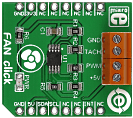
|
Fan click Released

Fan click carries an EMC2301 controller for powering and regulating the operation of 5V four-wire fans, which are commonly utilized as coolers in computers and other electronics. The controller supports PWM speeds from 9.5Hz to 29 KHz, in four programmable frequency bands. The control algorithms and the clock inside the circuit allow you to regulate the RPM of a given fan with 1% accuracy in the 500-16k RPM range. The TACH pin gives feedback on the fan's operation. Fan click also incorporates detection of aging fans, and alert on fan stall (the fan driver even attempts to fix a stalled fan while sending the interrupt) These alerts are sent through the mikroBUS INT pin. Otherwise, Fan click communicates with the target MCU through an I2C interface.
|
2015/11/23 |


|
Shake2Wake click Released

Shake2Wake click carries an ADXL362 ultralow power, 3-axis MEMS accelerometer from Analog Devices. The distinguishing feature of this IC is that it incorporates several activity detection modes. The interrupt pins from the chip are connected to an onboard ADP195 power switch IC that in turn controls an external device connected through a screw terminal. The detection threshold is configurable (both intensity and duration). The duration of inactivity that leads to switching off is also programmable. Shake2Wake click can also be used as a regular accelerometer, for continuous sensing, in which case it communicates with the target MCU through mikroBUS SPI interface. Uses 3.3V power supply only.
|
2015/11/18 |

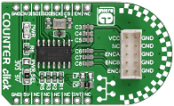
|
Counter click (Encoder Reader) Released

Counter click carries an LS7366R 32-bit quadrature counter. The top of the board has a pinout for interfacing with incremental encoders. The interface has ENCA and ENCB pins, along with ENCI, which is a programmable index. The A and B pulses fron an encoder are out of phase to each other, ideally by 90°. The LS7366R CMOS counter takes these signals as inputs and decodes them for determining direction and speed. On the other side, Counter click communicates with the target board microcontroller through the mikroBUS SPI interface (CSK, MISO, MOSI), plus enable (CNT EN) and interrupt (LFLAG) pins. The board can use either a 3.3V or a 5V power supply.
|
2015/11/18 |

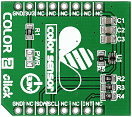
|
Color 2 click Released

Color 2 click carries the ISL29125 RGB color light sensor. It detects red, green and blue in a variety of lighting conditions, outputting 16-bit resolution data in a 5.7 m lux -10,000 lux measurement. Both the range and output resolution are selectable (narrower vs wider bandwidth, 12 vs 16 bit). The sensor also incorporates an IR blocking filter, allowing Color 2 click to work even under a dark glass cover. The integrated ADC also rejects 50Hz and 60Hz flicker from artificial light sources. The board communicates with the target MCU through the mikroBUS I2C interface (SCL and SDA pins). A programmable interrupt pin is also available. The board is designed to use a 3.3V power supply only.
|
2015/11/18 |

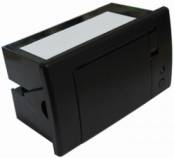
|
New Product: Thermal Printer

The CSN-A2 thermal printer is similar to what you would find on a credit-card POS machine. With a simple serial UART (TTL) interface, this unit has the ablity to print strings and bitmap images, as well as generate several different formats of barcodes. It uses a 12V power supply with the maximun current draw of 1.5A.
Printing speed is 50-80mm/s, with a resolution of 8 dots per millimetre (around 384 dots per line) and an effective printing width of 48mm.
The thermal paper that is used in the printer is commonly found in most office supply stationary stores and is sized at 57mm ±0.5mm thick, with a maximun paper roll diameter of 39mm (larger rolls can be made smaller to fit by simply removing some extra paper - this paper can then still be used in the unit, as one does not need to use a 'core' in the paper for it to work with the thermal printer).
|
2015/11/16 |


|
New Product: Solenoid Lock

Solenoids are basically electromagnets: they are made of a big coil of copper wire with an armature (a slug of metal) in the middle. When the coil is energized, the slug is pulled into the center of the coil.
This solenoid is durable and is designed for a small cabinet/door/safe. It has a slanted cut armature and a mounting bracket. The armature (metal slug) of the solenoid can be rotated 90, 180 or 270 degree to suit the position of the door just like a normal home door lock would.
|
2015/11/16 |


|
Heart Rate click Released

Heart Rate click carries Maxim's MAX30100 integrated pulse oximetry and heart-rate sensor. It's an optical sensor that derives its readings from emitting two wavelengths of light from two LEDs – a red and an infrared one – then measuring the absorbance of pulsing blood through a photodetector. This particular LED color combination is optimized for reading the data through the tip of one's finger. The signal is processed by a low-noise analog signal processing unit and communicated to the target MCU through the mikroBUS I2C interface. Developers of end-user applications should note that the readings can be negatively impacted by excess motion and changes in temperature. Also, too much pressure can constrict capillary blood flow and therefore diminish the reliability of the data. A programmable INT pin is also available. Uses 3.3V power supply.
|
2015/11/11 |

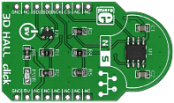
|
3D Hall Click Released

3D Hall click carries the MLX90333 Triaxis Hall sensor, capable of detecting the position of any magnet in nearby space. It does so by being sensitive to three components of flux density (BX, BY, BZ). The chip functions as a contactless position sensor for any type of magnet, capable of measuring its rotational, linear and 3D displacement with a high degree of precision. Contactless coupling ensures resistance against wear and environmental contaminants such as dirt and dust. The on-chip signal processing circuitry simplifies integration. The board communicates with the target MCU through the mikroBUS SPI interface (CS, SCK, MISO, MOSI). The board is designed to use a 5V power supply only.
|
2015/11/10 |


|
7x10 click Released

7x10 R click carries a matrix of 70 red LEDs driven by a pairs of 8-bit serial-in, parallel-out shift registers, a Darlington Transistor array and a Johnson counter. 7x5 is a standard resolution for displaying ASCII characters, so 7x10 click is essentially a dual-character display capable of showing letters in more readable typefaces compared to a 14-segment display. The click communicates with the target MCU through the mikroBUS SPI interface (SCK, SDO, SDI), with additional functionality provided by R CLK, MR#, LATCH and R RST pins. 7x10 R click is designed to use either a 3.3V or a 5V power supply.
|
2015/11/10 |

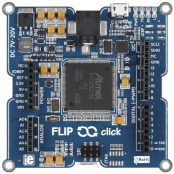
|
Flip & click SAM3X Released

Flip & click is like an Arduino on one side, but with the added functionality of four mikroBus sockets on the other. This makes it easy for users familiar with Arduino to include functionality from the huge range (160+) of click boards in their designs. The board features an AT91SAM3X8E microcontroller (the same MCU as found on the Arduino Due), the familiar Arduino Uno pinout, and the four mikroBus sockets on the back. In addition to this, four LEDs and a USB host/device connector are also included.
|
2015/11/05 |


|
IR Distance click Released

IR distance click carries Sharp's GP2Y0A60SZ0F distance measuring sensor. The sensor module comprises an integrated PSD (position sensitive detector), an infrared LED and a signal processing circuit. The measuring range is between 10 and 150 cm. The sensor is not easily influenced by the reflectivity of the object, but it's important to keep the lens clean. The click board outputs an analog voltage corresponding to the distance of the object (through the mikroBUS AN pin). An Enable (EN) pin is also utilized. The board is designed to use either a 3.3V or a 5V power supply.
|
2015/11/05 |


|
Vibra Sense click Released

Vibra Sense click is a low cost micro shock vibration sensor with a digital output which can be set as an Interrupt (mikroBUS INT pin) An onboard potentiometer lets you set the interrupt threshold. An additional Enable line (EN) is in place of the mikroBUS pin. It's a very simple and effective solution for detecting vibrations. The sensing unit consists of a round housing in which a spring is coiled around a metal pin. When exposed to vibration, the spring contacts the pin and closes the switch. The board is designed to use either a 3.3V and a 5V power supply.
|
2015/11/05 |

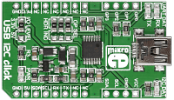
|
USB I2C click Released

USB I2C click carries an MCP2221 USB-to-UART/I2C converter. The chip supports full-speed USB (12 Mb/s), I2C with up to 400 kHz clock rates and UART baud rates between 300 and 115200. The board communicates with the target MCU through mikroBUS UART (RX, TX) or I2C (SCL, SDA) interfaces. In addition to mikroBUS, the edges of the board are lined with additional GPIO and I2C pins. It can operate on 3.3V or 5V logic levels.
|
2015/11/05 |

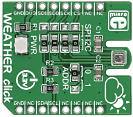
|
Weather click Released

Weather click carries BME280 integrated environmental unit from Bosch. It's a sensor that detects humidity, pressure and temperature, specifically designed for low current consumption and long term stability. Those features make it ideal for applications like home automation control, personalized weather stations, sport and fitness tools and so on. The sensor has three operating modes: sleep, forced, and normal. Also, the humidity and pressure sensors can operate independently. Weather click can communicate with the target MCU either through mikroBUS SPI or I2C interfaces. The board is designed to use a 3.3V power supply.
|
2015/11/05 |

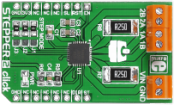
|
Stepper 2 click Released

Stepper 2 click carries a A4988 microstepping motor driver along with screw terminals for connecting a motor and a required external power supply (minimum 7V). The output drive capacity of the motor is up to 35V and ±2A. The A4988 chip is designed to drive bipolar stepper motors in full-, half-, quarter-, eight-, and sixteenth-step modes. A set of three onboard jumpers (J1-J3) allow you to switch between the different stepping modes. The board communicates with the target MCU through EN, RST, SL, ST and DIR pins (corresponding to AN, RST, CS, PWM and INT pins of the default mikroBUS configuration). Stepper 2 click can use both a 3.3V and 5V power supply.
|
2015/11/05 |

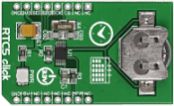
|
RTC5 click Released

RTC5 click carries MCP79510, a real-time clock/calendar with an SPI interface (mikroBUS MISO, MOSI, SCK and CS pins); along with a programmable interrupt for system output. The clock frequency is derived from an onboard 32.768KHz oscillator. For backup power, RTC5 click has a coin-cell Lithium polymer battery connector. The chip has 64-bytes of battery-backed SRAM and 1 kbit of EEPROM for storing data, along with 128 bits of protected space for storing a unique ID. The clock/calendar automatically compensates for leap years and months shorter than 31 days. The board is designed to use a 3.3V power supply only.
|
2015/11/05 |

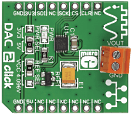
|
DAC2 click Released

DAC2 click carries LTC2601CDD, a 16-bit digital-to-analog converter, along with voltage output screw terminals. The chip has high rail-to-rail output drives (±15mA, Min) and double-buffered data latches. The click board communicates with the target MCU through the mikroBUS SPI interface with clock rates up to 50MHz. Additionally, the CLR pin, in place of default mikroBUS RST pin, clears all the registers. The board uses either a 3.3V or 5V power supply. You can also set the reference voltage either to VCC or 4.096V.
|
2015/11/05 |

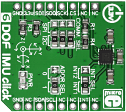
|
6DOF IMU click (Accel, Gyro) Released

6DOF IMU click is a mikroBUS add-on board that carries ST's LSM6D33 IC, which is 6-axis inertial measurement unit comprising a 3-axis gyroscope and a 3-axis accelerometer. The chip is a highly accurate 6 DOF inertial measurement unit with long-term stable operation over a wide range of temperatures. It's high robustness to mechanical shock makes is suitable for designing reliable platform stabilization systems, for example in cameras and drones. The board communicates with the target MCU either through I2C or SPI interfaces (along with an additional INT pin).
|
2015/11/05 |

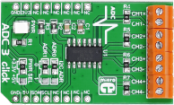
|
ADC3 click Released

ADC3 click carries Microchip's MCP3428 16-bit multichannel analog-to-digital converter. The click has four pairs of screw terminals onboard, letting you access the chip's four differential input channels. At the highest resolution of 16-bits, the chip outputs conversion results at 15 samples per second. At 14-bits, the sample rate is 60 SPS. Maximum conversion speed is achieved in 12-bit mode, 240 samples per second. A pair of onboard jumpers allow switching between different I2C addresses. ADC3 click communicates with the target MCU through mikroBUS I2C pins (SCL, SDA). It is designed to use either a 3.3V or 5V power supply.
|
2015/11/04 |


|
EnOcean click Released

EnOcean click carries a TCM310 transceiver, which is a bidirectional gateway for EnOcean's 868 MHz radio systems. This low-powered wireless module is intended for use together with EnOcean's range of energy harvesting modules. These are miniaturized converters that harness energy from motion, light or temperature differences - they come in the form of self-powered, battery-free wireless switches, sensors and actuators. EnOcean click communicates with the target MCU through the mikroBUS UART interface (TX, RX), with additional functionality provided by the Reset (RST) and Enable (mikroBus PWM) pins. The board may be powered by 3.3V only.
|
2015/10/22 |

|

